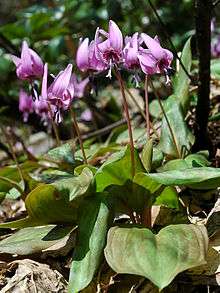Erythronium japonicum
Erythronium japonicum, known as Asian fawnlily,[2] is a pink-flowered species trout lily, belonging to the Lily family and native to Japan, Korea, the Russian Far East (Sakhalin Island, Kuril Islands) and northeastern China (Jilin and Liaoning).[3][4] It is a spring ephemeral, blooming April–June in woodlands. It is known as zhūyáhuā (猪牙花) in Chinese, eolleji (얼레지) in Korean, and katakuri (片栗) in Japanese.
| Erythronium japonicum | |
|---|---|
 | |
| Scientific classification | |
| Kingdom: | Plantae |
| Clade: | Tracheophytes |
| Clade: | Angiosperms |
| Clade: | Monocots |
| Order: | Liliales |
| Family: | Liliaceae |
| Genus: | Erythronium |
| Species: | E. japonicum |
| Binomial name | |
| Erythronium japonicum | |
| Synonyms[1] | |
| |
Erythronium japonicum has a stem up to 20 centimetres (7.9 in) long, although as much as 30% of the stem may be underground. Bulb is elongated, up to 6 cm (2.4 in) long but rarely more than 1 cm wide (0.39 in). Leaves are broadly elliptical to lanceolate, the blade up to 12 cm (4.7 in) long and 7 cm (2.8 in) wide. Flowers are solitary, rose-colored.[3][5][6][7][8][9]
Applying the generic common name trout lily may be somewhat of a misnomer, because in the Japanese species, the individual plant may or may not exhibit the flecked dark markings on the leaves, which is emblematic of that common name (see gallery below).
Protective status
Reporting is mixed on whether it should be regarded as endangered in Japan. One source adds it to a list of wildflowers that should be included as endangered,[10] but the so-called Eco kentei or environmental specialist certification, run by the Tokyo Chamber of Commerce and Industry (TCCI), has had an exam question in the past, where the correct answer to "Is katakuri endangered" was "no".[11] The Japanese ministry (MOE)'s version of the Red Data Book has not handed down an assessment of the whole species,[12] even though in the Red Data Book compiled by individual prefectures, its status is evaluated at "near threatened" (jun-zetsumetsu kigu shu) in Hyōgo and Mie,[12] and rated vulnerable-endangered in Shikoku and southern Kanto.[12]
This woodland plant is more vulnerable, since it has a very short season and is slow-growing.[10] It needs to grow into a 7–8 year old plant before it finally blooms,[10][13] so will not rebound in numbers once taken. In Niiharu (Midori-ku, Yokohama), the colony was entirely wiped out (poached) overnight shortly after media coverage about it blooming in the area.[13]
A colony that can be viewed within the confines of metropolitan Tokyo is at Shimizuyama-ikoi-no-mori which translates approximately to "Shimizuyama grove of respite", in Nerima-ku. This is somewhat in the neighborhood of the Tomitaro Makino memorial garden which also has a small number of plants planted.
Uses
The katakuriko (片栗粉, "katakuri powder"), is a starch that bears the name of this plant, which originally refers to the starch from the E. japonicum bulb. Because of its small quantity, this starch is no longer common; potato starch has taken its place and name nowadays.
This plant is not known to be farmed, and has been harvested from wild colonies by poachers, but probably not by seekers of starch sources, but by wildflower enthusiasts or traffickers.[14]
The plant powder was also used as ointment to treat rashes.[15]
The rumor that it is used in wagashi, particularly in the confection called katakuri-rakugan is apocryphal, since historian Kahei Mori states that this confection, which used to be traditionally presented to Morioka Domain, was made from the starch of lily bulbs.[16]
Additional photos
| Wikimedia Commons has media related to Erythronium japonicum. |
References
- The Plant List
- English Names for Korean Native Plants (PDF). Pocheon: Korea National Arboretum. 2015. p. 358. ISBN 978-89-97450-98-5. Archived from the original (PDF) on 25 May 2017. Retrieved 4 January 2017 – via Korea Forest Service.
- Flora of China v 24 p 126
- "Kew World Checklist of Selected Plant Families". apps.kew.org.
- Decaisne, Joseph. 1854. Revue Horticole, sér. 4, 3: 284.
- P.Y.Fu & Q.S.Sun. 1992. Flora Liaoningica 2: 1159.
- I.Yamam. & Tsukam. 1932. Flora Hakodate 192.
- Sun, Q.S. 1995. Bulletin of Botanical Research, Harbin 15(3): 332–333.
- Okuyama. 1955. Journal of Japanese Botany 30: 32.
- Okui 2005
- eco検定合格プロジェクト (2010). eco検定問題集決定版過去問・一問一答・模擬|秀和システム., p.199
- Association of Wildlife Research; EnVision (2007). "Red Data Book search (Erythronium japonicum)". Archived from the original on 2014-10-15. Retrieved April 2012. Check date values in:
|accessdate=(help)CS1 maint: ref=harv (link). yellow=jun-zetsumetsu kigu shu(NT); orange=絶滅危惧IB (VU); mauve=絶滅危惧I (EN/CR). See ja:template:生物分類表 - Kogure 2011
- Cf. Kogure 2011. The author does not explicit state this for the case of the apprehended poacher, but it is implicit, as it carries over from his discussion concerning the impact of poaching on orchids (shunran, ebine etc.) and other countryside species.
- "片栗粉". ブリタニカ国際大百科事典 小項目事典 at kotobank.jp (in Japanese). Retrieved August 5, 2015.
- Mori, Kahei(森嘉兵衛) (1972). 岩手県の歴史 (history of Iwate Prefecture) (snippet). Yamakawa Shuppansha(山川出版社). p. 62.CS1 maint: ref=harv (link) 「藩の献上菓子たる片栗落雁(百合根からとった殿粉によって製した菓子)とともに有名な献上品である。」
- Kogure, Katsuji(小暮勝治) (2011). 里山讃花: 私の花散歩・自然観察記 (Satoyama sanka: watashi no hana sanpo / shizen kansatsuki) (preview). Bungeisha(文芸社. ISBN 978-4887377042.CS1 maint: ref=harv (link), p. 149-150
- Okui, Noriyuki(奥井則行) (2005). 環境教育の試み: 身近な生物的自然を活用して(Kankyo kyoiku no kokoromi: mijika na seibutsu-gaku teki shizen wo katsuyo shite). Bungeisha(文芸社). pp. 88–90. ISBN 4835585976.CS1 maint: ref=harv (link)


